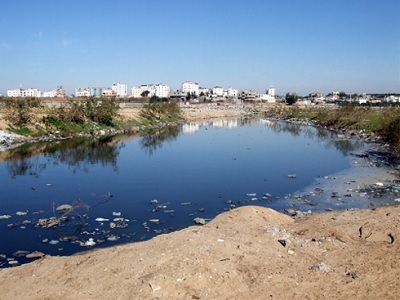
A dry winter in the Middle East is being studied particularly closely in Gaza, where the area’s 1.9 million residents already face a number of largely man-made threats to water security.
The following round-up of recent publications by think tanks, analysts and human rights organizations highlights the close link between water security and electricity supplies, and the near exhaustion of Gaza’s coastal aquifer.
A power crisis in the Occupied Palestinian Territory (OPT) has reduced the availability of running water in most households, according to a fact sheet produced by the UN Office for the Coordination of Humanitarian Affairs (OCHA), with more than 30 percent of homes in Gaza receiving running water for just 6-8 hours every four days.
In March, a petition signed by nearly 13,000 people and organized by the Emergency Water and Sanitation-Hygiene Group (EWASH), a coalition which includes national and international NGOs and UN agencies, was handed to the European Parliament to urge action to end the water crisis in Gaza.
“The scale and severity of the wa¬ter crisis facing the Gaza Strip is enormous, and unless immediate action is taken, the damage to Gaza’s natural water resources will be irreversible,” says a factsheet produced by the Palestinian Water Authority (PWA).
At least 90 percent of the water supply in Gaza is contaminated with a combination of nitrate (NO3) or chloride (Cl), according to PWA, which says water quantity is also an issue, with average consumption of 90 litres per person per day, below recommended guidelines for minimum health requirements say EWASH.
In the coming years, the population of Gaza is expected to continue growing, creating increased water and power needs. The power supply required to operate current water and wastewater facilities (29 megawatts) is expected to rise to 81.5 MW by 2020, according to PWA, as the population grows and new water projects are built.
“The insufficient supply of electricity and fuel to operate water pumps and wells has caused a further reduction in the availability of running water in most households. This has increased people’s reliance on private, uncontrolled water suppliers and lowered hygiene standards,” reads OCHA OPT’s March fact sheet.
Israel is the main source of electricity in OPT, with 4,702 gigawatt hours purchased from Israel in 2012, constituting 89 percent of its total energy purchases. The Gaza Strip, specifically, is supplied with electricity from three sources: purchases from Israel (120 megawatts) and from Egypt (28 MW) and production by the Gaza Power Plant (GPP) (currently 60 MW). According to OCHA, this supply meets less than half of the estimated demand.
In a recent report on water in OPT, Friends of the Earth says: “Water injustice and inequitable allocation of water to Palestinian people has seriously deteriorated the overall economic and social well-being of the people… The majority of water resources are concentrated in the hands of Israel, while the Palestinian population endures significant water deficits.”
In a press release issued in February, the Israeli human rights organization B’Tselem said the Israeli government was largely responsible for this discrimination due its water policy: “Minimal amounts of water are supplied to Palestinians and water from shared resources is unequally divided.”
The Israel Water Authority on the other hand says Israel goes well beyond existing water obligations in providing additional water supplies to OPT. It says uncontrolled drilling in OPT is a major threat to supply: “Over 300 unauthorized wells were drilled by the Palestinians in the West Bank. These unauthorized wells may ruin the shared aquifer as they almost completely ruined the one in Gaza and caused an ecological disaster.”
Almost all the water in Gaza comes from the coastal aquifer, which is shared with Israel. “[D]ue to the absence of any policy coordination between Israel and the Gaza Strip with regard to the Coastal Aquifer, both authorities are currently over-extracting,” says EWASH.
A UN report in August 2012 entitled Gaza in 2020 forecast that at current rates of deterioration the coastal aquifer will become unusable by 2016 and beyond repair by 2020.
In 2009 the UN Environment Programme recommended ending abstraction from the aquifer completely, but with low rainfall and no year-round rivers, Gaza has few other options.
PWA has long-term plans for a central desalination plant and short-term plans for several low-volume desalination projects, wastewater treatment plants and developing treated wastewater reuse for irrigation. But given the challenges posed by the blockade and electricity shortages, the viability of such plans is in question.
While large-scale emergency and strategic water desalination and wastewater treatment projects are necessary to provide for the population in the future, without adequate power sources, these projects will only add to the challenges.
As part of its 2014 response plan for OPT, the UN has appealed for US$25 million to help improve access to basic water, sanitation and hygiene (WASH) services for 1.9 million of the people in need. So far, the chronically underfunded WASH sector is just 5.6 percent funded, well below the average of 18 percent for other clusters.
(IRIN – www.irinnews.org)





